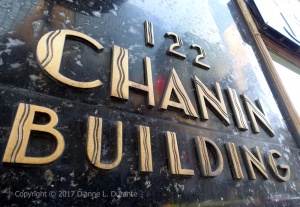To illustrate this post, I went yesterday to take photos of the reliefs in the lobby of the Chanin Building. From the full length of the lobby (a city block long), a security guard yelled, “No photos!” I got in touch with the building manager: the No Photos rule is apparently inviolable. Since I respect private property and (unlike the government!) recognize that allowing people access to it doesn’t make it less your property, I have to accept the choices of the Chanin Building’s management. But … Ladies and Gentlemen: if you don’t want photos taken, why not 1) post a sign at each entrance, and 2) have someone take a photo of each of the reliefs and all the bronzework, and upload the photos to the Chanin Building’s page on Wikipedia? Then the building’s employees can honestly say that there are photos of every detail available online.
Irwin Chanin (1891-1988) got his start building two small homes in Bensonhurst that sold for $7,000 each. By the 1920s he became a real-estate mogul, constructing hotels, theaters, and apartment houses in Manhattan, and creating suburban developments such as Green Acres in Valley Stream. But the building that he was proudest of is the one that bears his name: the 56-story Chanin Building, on the southwest corner of Lexington Avenue at 42nd Street, caddy-cornered from the Chrysler Building. The Chanin Building, completed, in 1929, was advertised as a melding of art and commerce: “architectural beauty wedded to business efficiency.” According to Reynolds:
Chanin wished his building to convey the message he learned early in life: that any individual in New York City may rise from humble beginnings to wealth and influence through the use of his mind and hands. For Chanin, the building itself embodies these principles, but he had them translated into narrative and symbolic language through a program of sculpture and decorative detail. (The Architecture of New York City, rev. ed., 1994, p. 279)
The exterior friezes of the Chanin Building
The sculptor of most of the decoration on the Chanin Building is Rene Chambellan, whose more familiar work is the row of sea creatures at Rockefeller Center. (See More, below.) For the frieze just above the first floor on the outside of the Chanin Building, Chambellan sculpted a bronze relief of plants, fish and birds that represents the evolution of life from the sea. This is the frieze running on the northwest side of the building.
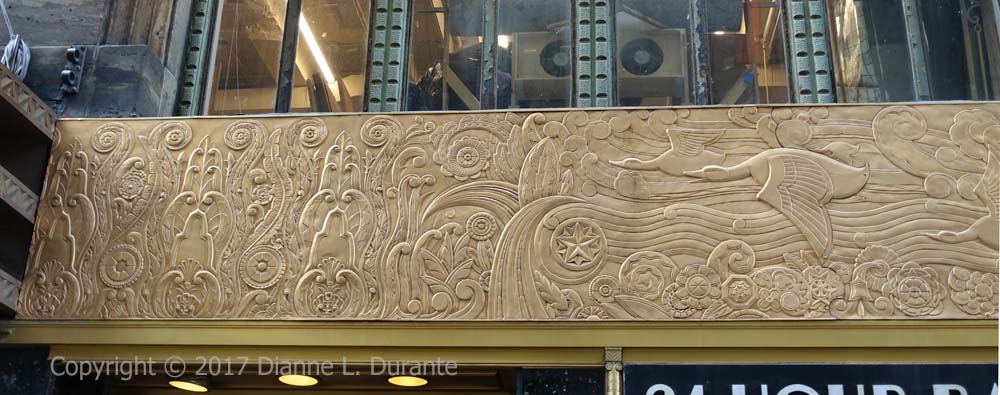
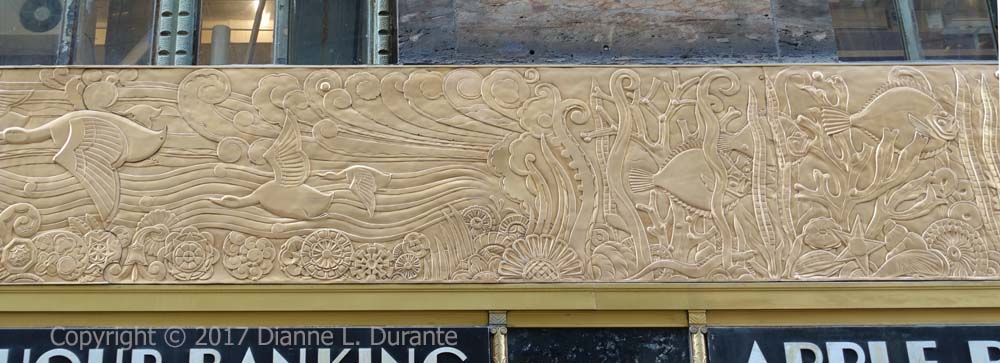
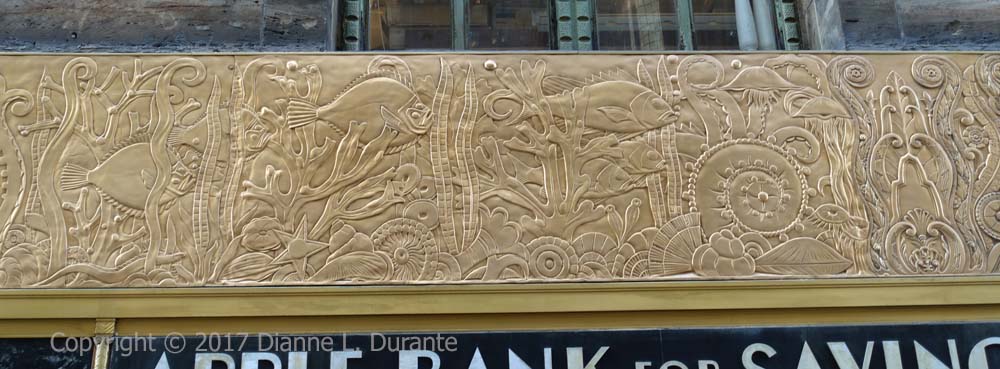
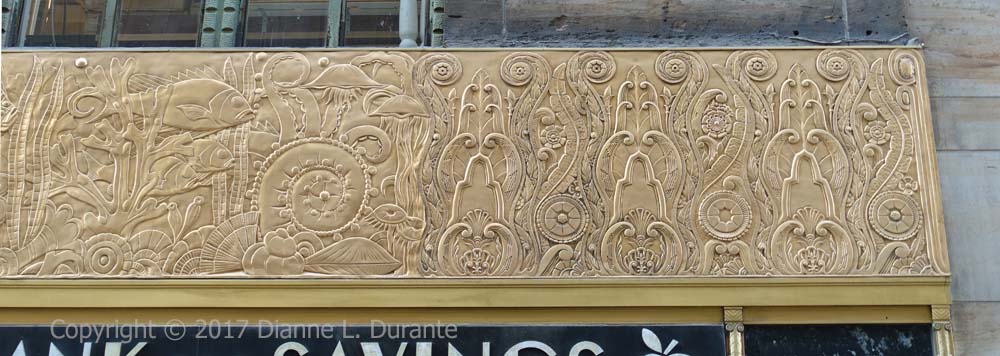
Above the bronze frieze are windows separated by columns topped by sea monsters. Above those is another frieze, this one terracotta, with stylized plants.
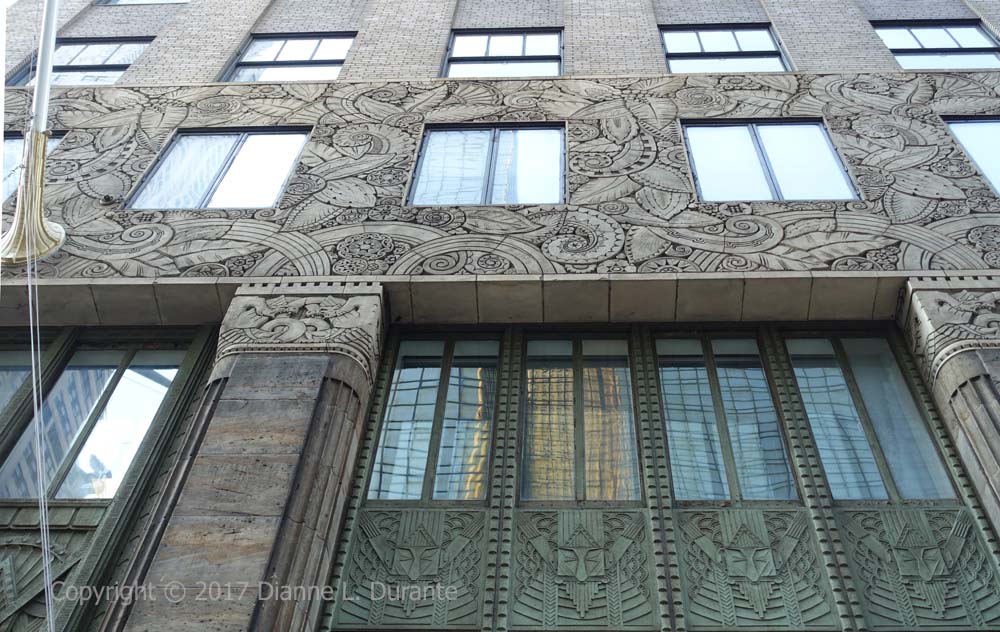
The lobby of the Chanin Building
Evolution is ascending from a lower to a higher form of life. The lobby’s decoration celebrates human improvement. According to an article published in 1929, the year the building was completed, the reliefs represent “the City of Opportunity … in which it is possible for a man to rise from a humble station to wealth and influence by sheer power of his mind and hands” (Glassgold, quoted in the NYC Landmarks report on the Chanin Building).
Around the lobby are eight plaster reliefs, painted to look like bronze. Six represent Effort, Activity, Endurance, Enlightenment, Vision, and Courage. The other two represent Achievement and Success. I was really looking forward to sorting out which of these is which: but since I don’t have pics, I can’t. Pics of three of them are on the New York Architecture site (scroll down). I’m assuming the photos are copyright, so I’m not pasting them in here.
I don’t normally get excited by geometric patterns, but those on the grills in the Chanin Building’s lobby are amazingly beautiful. According to Reynolds, scrolls represent the birth of ideas, rays represent the spark of genius, and blocky forms represent building. Again, for pics you’ll have to go to the New York Architecture site.
Chanin’s office
Chanin’s offices, on the fifty-second floor, include wrought-iron gates incorporating cogwheels and stacks of coins. Bronze plaques represent enterprises Chanin was involved with: the subways, bridges, and theater. This is the only image online of any part of that decor.
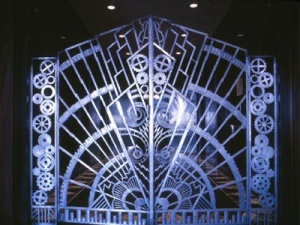
Chanin’s private bathroom was awarded the title “America’s Finest Bathroom” when the building opened in 1929. Its combination of brass, tile, ornaments and lighting was adapted for the bathrooms in his Majestic apartment complex at 115 Central Park West (just south of the Dakota). Yes, I have tried to find pictures. No, I haven’t succeeded.
Langdon Smith’s “Evolution”
While I don’t believe in transmigration of souls, I love this poem for its progression: from sea life to amphibians to monkeys to man, including speaking, making tools, creating art, writing laws, and dining in a fine restaurant.
When you were a tadpole and I was a fish
In the Paleozoic time,
And side by side on the ebbing tide
We sprawled through the ooze and slime,
Or skittered with many a caudal flip
Through the depths of the Cambrian fen,
My heart was rife with the joy of life,
For I loved you even then.Mindless we lived and mindless we loved
And mindless at last we died;
And deep in the rift of the Caradoc drift
We slumbered side by side.
The world turned on in the lathe of time,
The hot lands heaved amain,
Till we caught our breath from the womb of death
And crept into life again.We were amphibians, scaled and tailed,
And drab as a dead man’s hand;
We coiled at ease ‘neath the dripping trees
Or trailed through the mud and sand.
Croaking and blind, with our three-clawed feet
Writing a language dumb,
With never a spark in the empty dark
To hint at a life to come.Yet happy we lived and happy we loved,
And happy we died once more;
Our forms were rolled in the clinging mold
Of a Neocomian shore.
The eons came and the eons fled
And the sleep that wrapped us fast
Was riven away in a newer day
And the night of death was passed.Then light and swift through the jungle trees
We swung in our airy flights,
Or breathed in the balms of the fronded palms
In the hush of the moonless nights;
And oh! what beautiful years were there
When our hearts clung each to each;
When life was filled and our senses thrilled
In the first faint dawn of speech.Thus life by life and love by love
We passed through the cycles strange,
And breath by breath and death by death
We followed the chain of change.
Till there came a time in the law of life
When over the nursing sod
The shadows broke and the soul awoke
In a strange, dim dream of God.I was thewed like an Auroch bull
And tusked like the great cave bear;
And you, my sweet, from head to feet
Were gowned in your glorious hair.
Deep in the gloom of a fireless cave,
When the night fell o’er the plain
And the moon hung red o’er the river bed
We mumbled the bones of the slain.I flaked a flint to a cutting edge
And shaped it with brutish craft;
I broke a shank from the woodland lank
And fitted it, head and haft;
Than I hid me close to the reedy tarn,
Where the mammoth came to drink;
Through the brawn and bone I drove the stone
And slew him upon the brink.Loud I howled through the moonlit wastes,
Loud answered our kith and kin;
From west to east to the crimson feast
The clan came tramping in.
O’er joint and gristle and padded hoof
We fought and clawed and tore,
And cheek by jowl with many a growl
We talked the marvel o’er.I carved that fight on a reindeer bone
With rude and hairy hand;
I pictured his fall on the cavern wall
That men might understand.
For we lived by blood and the right of might
Ere human laws were drawn,
And the age of sin did not begin
Til our brutal tusks were gone.And that was a million years ago
In a time that no man knows;
Yet here tonight in the mellow light
We sit at Delmonico’s.
Your eyes are deep as the Devon springs,
Your hair is dark as jet,
Your years are few, your life is new,
Your soul untried, and yet —Our trail is on the Kimmeridge clay
And the scarp of the Purbeck flags;
We have left our bones in the Bagshot stones
And deep in the Coralline crags;
Our love is old, our lives are old,
And death shall come amain;
Should it come today, what man may say
We shall not live again?God wrought our souls from the Tremadoc beds
And furnish’d them wings to fly;
He sowed our spawn in the world’s dim dawn,
And I know that it shall not die,
Though cities have sprung above the graves
Where the crook-bone men made war
And the ox-wain creaks o’er the buried caves
Where the mummied mammoths are.
=
For we know the clod, by the grace of God
Will quicken with voice and breath;
And we know that Love, with gentle hand
Will beckon from death to death.
[The lines above do not appear in most published versions, but were included in the version published in The Book of Poetry (1927) edited by Edwin Markham.]
Then as we linger at luncheon here
O’er many a dainty dish,
Let us drink anew to the time when you
Were a tadpole and I was a fish.
More
- Jean Shepherd (radio and TV personality from the 1940s-1980s) reads “Evolution” aloud here; the images are from the 1909 edition.
- The Chanin Building was the first major Art Deco building in New York City. It was soon followed by Rockefeller Center, the Chrysler Building, and the Empire State Building.
- For a brief time before the completion of the Chrysler Building in 1930, the Chanin Building was the tallest structure north of Wall Street, and had more office space than the Woolworth Building. Its crown was lit at night with floodlights so powerful that the building was visible 45 miles away.
- Donald Martin Reynolds discusses the Chanin Building in detail in The Architecture of New York City: Histories and Views of Important Structures, Sites, and Symbols, rev. ed. (1994), pp. 274-280.
- More photos of the Chanin Building, mostly exterior: NYC-architecture, Scouting NY, NewYorkitecture, and Daytonian in Manhattan.
- The NYC Landmarks Commission report on the Chanin Building is here, without photos, alas.
- According to Gayle and Cohen (Art Commission and Municipal Society Guide to Manhattan’s Outdoor Sculpture, 1988), Rene Chambellan’s “Fountainhead Figures” at Rockefeller Center – a group of Tritons and Nereids riding dolphins – symbolize qualities that have spurred mankind ahead. From Fifth Avenue moving west toward the skating rink, they are: Leadership, Will, Thought, Imagination, Energy, and Alertness. I love the concept, but I don’t see those in the figures. … Would you like a post on these? Let me know: DuranteDianne@gmail.com.
- In the market for something in the $3 million plus range? Have a look at the available apartments in Chanin’s The Majestic.
- Want wonderful art delivered weekly to your inbox? Check out my free Sunday Recommendations list and rewards for recurring support: details here.
